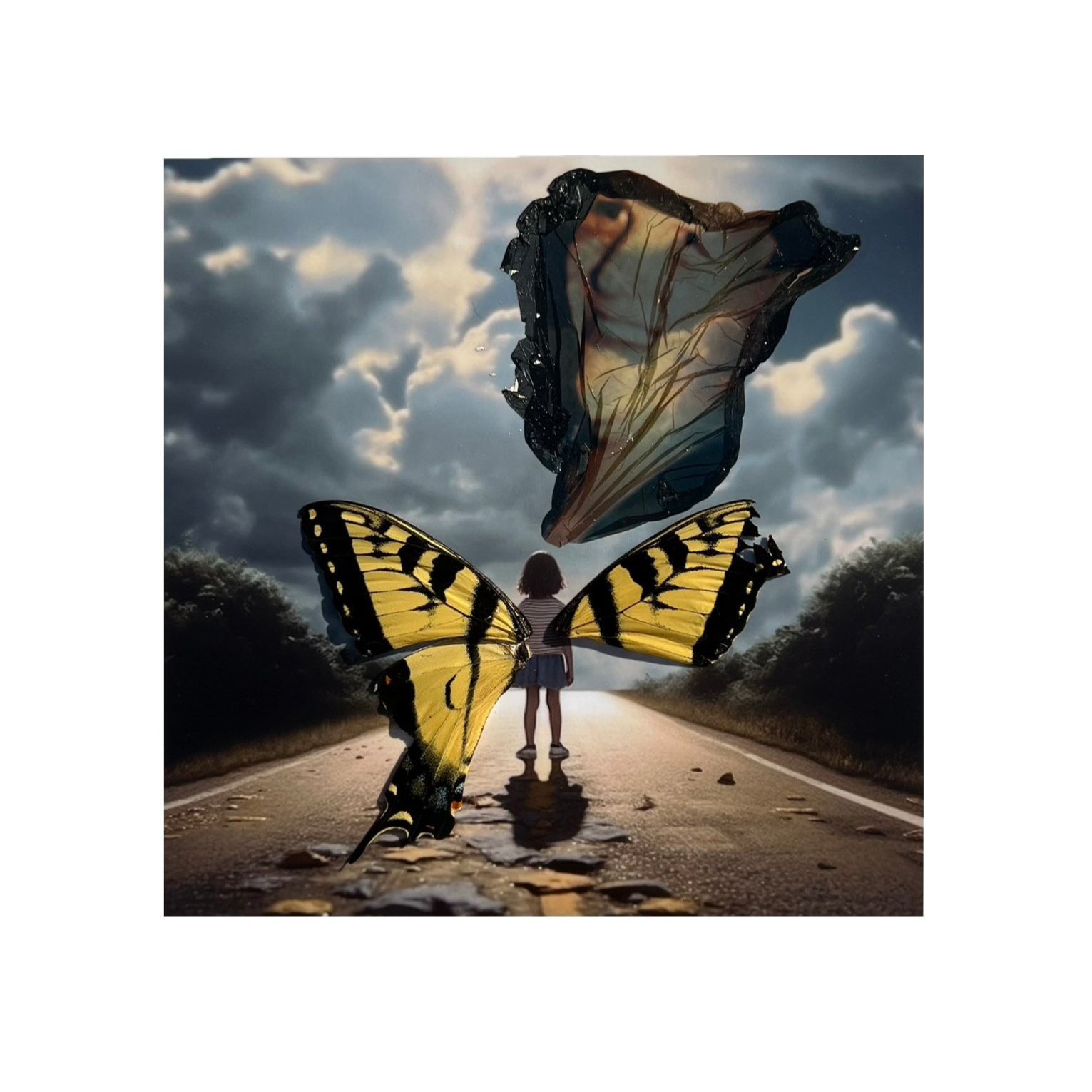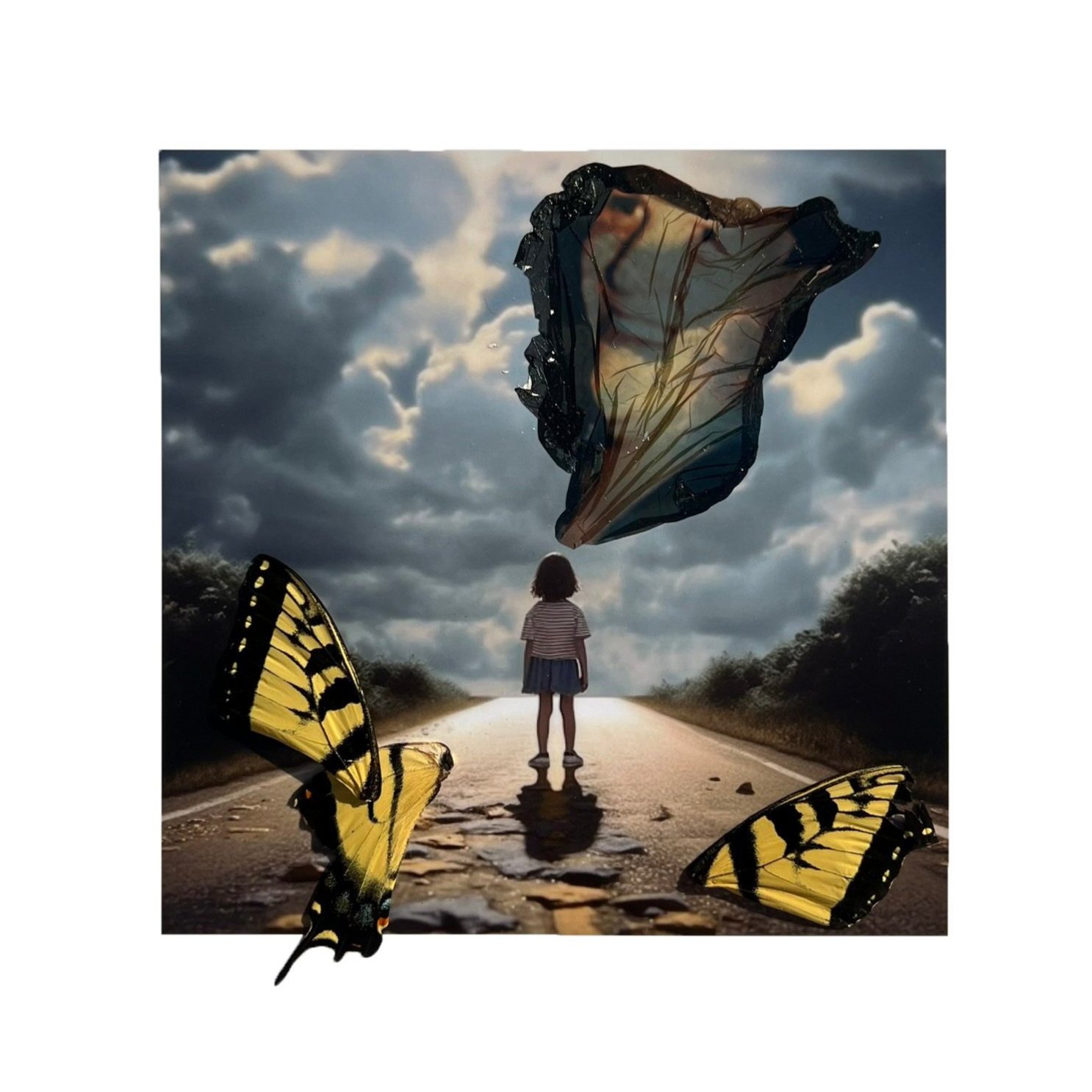In My Head/Without a Body
Laura Barth
In My Head/Without A Body, diptych of two collages with polaroid emulsion lift, each 6 x 6 inches
“I think art has the capacity to tap into something that science can’t explain.”
Interview by L. Valena
June 26, 2023
Can you please start by describing the prompt that you responded to?
This image really spoke to me on a number of levels. I’d found out that an old friend from high school had recently passed away. We weren't close now by any means, but they were a really good friend during a formative period of time, so I've been working through some of those feelings in some other art I did, and thinking a lot about metaphysics, and afterlife, and does the soul go anywhere? I was looking at this and I was struck by so many things. There's the atom in the background, which got me thinking about metaphysics or the conservation of energy. The head splits open and there's that hidden eye, which made me think of perception beyond our physical realm or our three-dimensional realm. Are there other universes? Are there other dimensions? Then there's that rib cage behind the head, which got me thinking about the body, and how all these things are maybe contained in our body and we pick up signs and we filter them out.
What really struck me about this were the butterflies. I’d done some silly Google searches about signs that a deceased loved one is contacting you from the afterlife. I felt almost childish doing that, but I had really wanted to talk to them again someday and now I'd never get the chance.. One sign was that you will see butterflies in unexpected places. And actually, just one day before I received the prompt, I was in the grocery store parking lot with my daughter, and we found three almost perfectly intact butterfly wings right on the cart corral thingy. I felt like, if I was getting some sort of sign in the form of butterflies, seeing a regular butterfly wouldn't stand out to me because where I live, there are butterflies all over the place. But seeing those three wings sitting there perfectly intact right when I stepped out of my car, and then right after that getting this prompt with all the butterflies, I was like, “Huh.” It would be really cool if this is a sign, but what if it's just all in my head and this is just me manifesting something? You know, it's just me, it's not… whatever is going on.
What if it’s all just part of the grand hallucination that we call life?
Exactly! That's the perfect way to sum it up. This one image encapsulates everything that I had been thinking of, even some of it super literally.
Yeah, so cool. We do very little curation there. We try to let the prompt choose the artist; that’s how this project works. And it's crazy how often things like this happen that feel almost spooky.
I think art has the capacity to tap into something that science can’t explain.
There's a reason we need both, right? So you got this prompt and you had lots of feelings. How did you get started on your piece?
Usually my process is pretty quick, especially for my recent stuff with emulsion lifts. It was born out of necessity because I’d just given birth to my daughter and I needed to do something that was kind of fast. I could only really work in short bursts. My response to the prompt itself didn't take longer once I got it, but I took longer to sit with it. I sat and thought about what I wanted to say. I did a little bit of journaling, just wrote down any thoughts I had. And then the weekend before it was due, it all came together in my head. I decided to respond super literally and tried to encompass exactly what I was thinking when I saw the prompt. And so most of the process was just sitting and thinking.
Sometimes for a background image I use a photo that I've already taken, but I didn't have one this time. I searched for one that was just a little girl standing in a road because I kind of felt childish and full of questions, and also my daughter and I had a conversation when we found the butterfly wings about what happened to its body. “Where is its body? Why are the wings here and not its body?” I felt like there were metaphorical aspects of that conversation that could be translated to my thoughts. So basically, this piece represents feeling childlike, feeling open to signs and trying to let down those filters. “Oh that can't possibly be true. This person isn't getting ahold of me through some butterfly wings in a parking lot or through this art that I got in an email.” It's about getting rid of those thoughts, being open, being full of questions.
I did an emulsion lift of an image of that friend at about the same age when we were friends. That floating up from the head, having them in the sky, is me asking, “Are they actually somewhere out there, giving me these signs? Or am I just thinking about them? Or is it both?” That’s more literal than I usually like to be, but it really just struck me to respond this way.
I knew I was going to use those butterfly wings for something. Usually when I find something like that, they’re all torn up. These were intact, so when I got the prompt, I was obviously going to use those wings. Originally, I was going to leave the wings on the road like where I found them, but then just for fun I decided to put them on the little girl. I wasn't originally going to do that, thinking it was way too obvious or even cliched, but then I put them on her and actually really liked it. I took a picture of the wings on the girl, and then the wind came and blew the wings off. So the second image was just the way the wings blew and landed on the picture. I really liked it, so I captured that as well.
Essentially, it's me, but with the soul of a child, contemplating everything I thought about as soon as I received that image.
So cool. I need to know more about this process because it’s very mysterious. What is an emulsion lift?
I recently saw somebody doing it on Instagram and it looked so otherworldly and ethereal. And it’s pretty easy to do, especially because Polaroid started making that film again. You have your Polaroid, you remove the backing and the white part. You can trim the edges off or not; there are variations on the process. You dismantle the Polaroid, and you take the part with the image on it and soak it in hot water. It floats off the backing and it’s really, really thin, and you can just stick it on a variety of surfaces. I like to do watercolor paper, but for this I stuck it on some resin-coated photo paper. Polaroids have a really nostalgic quality. They evoke memories, reminiscing in general. But I feel like it's even more so with an emulsion lift because it's almost like painting but with a photo. You can put the paper into the water and move it around which spreads it out in creative ways. I like to take the image out of the water and put it onto the paper and move it around. Sometimes it rips. I feel like you get a lot of creative results with that. The film comes off and then you can manipulate it however you want. There's something about the Polaroids, physically cutting them up and using them to translate memories.
Is this a Polaroid that you took of your friend, or is it a Polaroid that you took of a picture of your friend?
Polaroid has this thing called Polaroid Lab, which lets you create Polaroids from cell phone photos. So it's an image that I got from social media, saved on my cell phone, and then I turned it into a Polaroid using the Polaroid Lab and cut it up that way and did the lift.
Ohh that's really interesting.
It's a lot of fun. Some people on Instagram do things with them that are really beautiful.
It's so cool when there's some new discovery or way of working that just inspires other people. I think that's the most positive thing about Instagram. [laughs]
I agree! There are obviously negative things to be said about it, but I've actually found a lot of really cool artists and techniques and inspiration on there.
How does this relate to the rest of your work?
I guess it fits directly in with the process of journaling and working through emotions. And thinking about things that we can't necessarily explain through language very well, or even directly through our five senses, like perception, magic, spookiness, synchronicities, things like that. This was fun. I actually wasn't expecting it to fit into my normal process so well.
You work in science, don’t you? What kind of science do you do?
I'm a horticulturist.
Cool!
Yeah, I teach plant identification classes, and I work for the American Floral Endowment where I help with research projects. Finding university researchers, helping proposals through the peer-review process, things like that. One of the reasons I like horticulture is because there's an art to it, the art of cultivating plants and enjoying beauty. See, art and science – there’s some overlap!
That definitely feels like one of the places where science and art meet.
The research process is actually a really creative process too, people developing new methodologies, trial and error, and setting up these research experiments. When I was doing my master’s and we were setting up the experiments for that and some other projects, I was surprised at how creative a lot of it was. A lot of these kids I went to school with didn't view themselves as creative, but they really were. I took this one class that was The Creativity of Science, which was totally useful for the kids in that class. This genius soil chemistry professor was teaching them how to be creative. We looked at art in class and puzzles and brain teasers. The professor was trying to get these kids to do these creative processes because science is inherently so creative. But they didn't see themselves as being creative or that science is artistic in any way, but it really, really is.
Do you have any advice for another artist approaching Bait/Switch for the first time?
I would say to be open. Be amazed. Appreciate what other people are doing. I also thought it was really fun to look through all of the prompts on the Instagram page and see the origins of how everything started and where it's going. Have fun! Go where your mind takes you and don’t be afraid to try something new or different if that’s where the prompt takes you. Stretch your mind a little bit. This was a really cool exercise and a neat thing to be a part of.
Call Number: M75VA | M77.baIn
Laura Barth is an artist, musician, and horticulturist from Eau Claire, Wisconsin currently living in the mountains of North Carolina. Primary media include photography (digital and analog), graphite, charcoal, and watercolor. Laura has a degree in music performance from the University of Wisconsin, Eau Claire, and a Bachelor's and Master's degree in horticulture from North Carolina State University.





